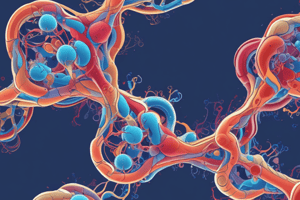Podcast
Questions and Answers
What happens to the enzymes when the body temperature rises from 37°C to 42°C?
What happens to the enzymes when the body temperature rises from 37°C to 42°C?
- They remain unaffected
- They become more active
- They change their substrate specificity
- They break down and are non-functional (correct)
What would happen to the chemical reaction normally facilitated by an enzyme if it has broken down and is non-functional?
What would happen to the chemical reaction normally facilitated by an enzyme if it has broken down and is non-functional?
- The reaction would proceed at the same rate
- The reaction would change its mechanism
- The reaction would proceed faster
- The reaction would slow down or stop (correct)
What is the primary mechanism of reversible competitive inhibition?
What is the primary mechanism of reversible competitive inhibition?
- Competing with the substrate for binding to the active site (correct)
- Binding to the active site and altering the tertiary structure
- Forming a covalent bond with the enzyme
- Binding to a site away from the active site
What is the effect of a non-competitive inhibitor on the enzyme's active site?
What is the effect of a non-competitive inhibitor on the enzyme's active site?
What is the characteristic of irreversible inhibition?
What is the characteristic of irreversible inhibition?
What is an example of irreversible inhibitors?
What is an example of irreversible inhibitors?
What is the effect of ATP on the enzyme PFK in the glycolytic pathway?
What is the effect of ATP on the enzyme PFK in the glycolytic pathway?
What is a characteristic of allosteric enzymes in terms of their quaternary structure?
What is a characteristic of allosteric enzymes in terms of their quaternary structure?
What is the purpose of releasing proteolytic enzymes as zymogens?
What is the purpose of releasing proteolytic enzymes as zymogens?
How is a zymogen activated?
How is a zymogen activated?
What is the function of the active site in allosteric enzymes?
What is the function of the active site in allosteric enzymes?
What is the role of proteolytic enzymes in blood clotting?
What is the role of proteolytic enzymes in blood clotting?
What is the effect of a positive regulator on the activity of an allosteric enzyme?
What is the effect of a positive regulator on the activity of an allosteric enzyme?
What is the effect of excess ATP on the glycolytic pathway?
What is the effect of excess ATP on the glycolytic pathway?
What is the effect of a negative regulator on the activity of an allosteric enzyme?
What is the effect of a negative regulator on the activity of an allosteric enzyme?
What is the mechanism by which allosteric enzymes are regulated in feedback control?
What is the mechanism by which allosteric enzymes are regulated in feedback control?
What is the term for the inhibition of an enzyme by a molecule that binds to a site other than the active site?
What is the term for the inhibition of an enzyme by a molecule that binds to a site other than the active site?
What is the relationship between the active and regulatory binding sites in allosteric enzymes?
What is the relationship between the active and regulatory binding sites in allosteric enzymes?
Flashcards are hidden until you start studying




